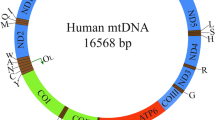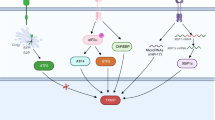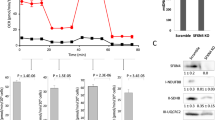Abstract
Cancer cells have high levels of thioredoxin (Trx) and of glyceraldehyde 3-phosphate dehydrogenase (GAPDH). Cells from patients with the cancer-prone disease Fanconi anemia (FA) exhibit reduced Trx levels. We found the activity of GAPDH to correlate directly with the endogenous Trx content and mRNA transcripts for GAPDH and TRx reduced in FA cells. The treatment of cells with reduced human Trx stimulated the synthesis of GAPDH mRNA. Similarly, the transfection of cells with an expression plasmid for Trx increased GAPDH mRNA synthesis. Trx treatment of cells and subsequent analysis of the differential gene expression by human cDNA arrays containing about 50 000 different PCR products resulted in more than 300 up- or downregulated genes. Two representative genes, GAPDH and IκBα/MAD-3, were further investigated to confirm their stimulation by Trx. Trx besides being the major carrier of redox potential of cells is also a regulator of gene expression on the transcriptional level. By regulation via Trx, cells are able to adapt to the prevailing redox conditions. These findings also enlighten the pathophysiology of FA in the respect that the characteristic diminution of Trx that results in the dysregulation of gene expression is a basis for the major symptoms of this disease.
This is a preview of subscription content, access via your institution
Access options
Subscribe to this journal
Receive 50 print issues and online access
$259.00 per year
only $5.18 per issue
Buy this article
- Purchase on Springer Link
- Instant access to full article PDF
Prices may be subject to local taxes which are calculated during checkout








Similar content being viewed by others
References
Arnér ESJ and Holmgren A . (2000). Eur. J. Biochem., 267, 6102–6109.
Ashmarina LI, Louzenko SE, Muronetz VI and Nagradova NK . (1988). FEBS Lett., 231, 413–416.
Baxi MD and Vishwanatha JK . (1995). J Pharmacol. Toxicol. Methods, 33, 121–128.
Bertini R, Howard OM, Dong HF, Oppenheim JJ, Bizzarri C, Sergi R, Caselli G, Pagliei S, Romines B, Wilshire JA, Mengozzi M, Nakamura H, Yodoi J, Pekkari K, Gurunath R, Holmgren A, Herzenberg LA, Herzenberg LA and Ghezzi P . (1999). J. Exp. Med., 189, 1783–1789.
Boer JM, Huber WK, Sultmann H, Wilmer F, von Heydebreck A, Haas S, Korn B, Gunawan B, Vente A, Fuzesi L, Vingron M and Poustka A . (2001). Genome Res., 11, 1861–1870.
Brot N and Weissbach H . (1991). Biofactors, 3, 91–96.
Dalton TP, Schertzer HG and Puga A . (1999). Annu. Rev. Pharmacol. Toxicol., 93, 67–101.
Das KD, Lewis-Molock Y and White CW . (1997). Am. J. Respir. Cell. Mol. Biol., 17, 713–726.
Dastoor Z and Dreyer JL . (2000). J. Cell Sci., 114, 1643–1653.
Durrieu C, Bernier-Valentin F and Rousset B . (1987). Arch. Biochem. Biophys., 252, 32–40.
Hayashi T, Ueno Y and Okamoto T . (1993). J. Biol. Chem., 268, 11380–11388.
Hirota K, Murata M, Sachi Y, Nakamura H, Takeuchi J, Mori K and Yodoi J . (1999). J. Biol. Chem., 274, 27891–27897.
Holmgren A . (1989). J. Biol. Chem., 264, 13963–13966.
Huber HE, Tabor S and Richardson CC . (1987). J. Biol. Chem., 262, 16224–16232.
Ishitani R, Sunaga K, Hirano A, Saunders P, Katsube N and Chuang DM . (1996). J. Neurochem., 66, 928–935.
Ishitani R, Tanaka M, Sunaga K, Katsube N and Chuang DM . (1998). Mol. Pharmacol., 53, 701–707.
Kawamoto RM and Caswell AH . (1986). Biochemistry, 25, 657–661.
Kerblat I, Drouet C, Chesne S and Marche PN . (1999). Immunology, 97, 62–68.
Kontou M, Adelfalk C, Hirsch-Kauffmann M and Schweiger M . (2003). Biol. Chem., 387, 1501–1507.
Kontou M, Adelfalk C, Ramirez MH, Ruppitsch W, Hirsch-Kauffmann M and Schweiger M . (2002). Oncogene, 21, 2406–2412.
Lillig CH, Prior A, Schwenn JD, Åslund F, Ritz D, Vlamis-Gardikas A and Holmgren A . (1999). J. Biol. Chem., 274, 7695–7698.
Messmer UK and Brune B . (1996). Eur. J. Pharmacol., 302, 171–182.
Meyer-Siegler K, Mauro DJ, Seal G, Wurzer J, DeRiel JK and Sirover MA . (1991). Proc. Natl. Acad. Sci. USA, 88, 8460–8464.
Muronetz VI, Wang ZX., Keith TG, Knull HR and Srivastava K . (1994). Arch. Biochem. Biophys., 313, 253–260.
Nagy E and Rigby WF . (1995). J. Biol. Chem., 270, 2755–2763.
Nakamura H, DeRosa S, Roederer M, Anderson MT, Dubs JG, Yodoi J, Holmgren A, Herzenberg LA and Herzenberg LA . (1996). Int. Immunol., 8, 603–611.
Nakamura H, Nakamura K and Yodoi J . (1997). Annu. Rev. Immunol., 15, 351–369.
Pekkari K, Gurunath R, Arner ES and Holmgren A . (2000). J. Biol. Chem., 275, 37474–37480.
Powis G and Montfort WR . (2001a). Annu. Rev. Biophys. Biomol. Struct., 30, 421–455.
Powis G and Montfort WR . (2001b). Annu. Rev. Pharmacol. Toxicol., 41, 261–295.
Powis G, Mustacich D and Coon A . (2000). Free Radic. Biol. Med., 29, 312–322.
Ramirez MH, Ruppitsch W, Hirsch-Kauffmann M and Schweiger M . (1999). Biochem. Biophys. Res. Commun., 264, 518–524.
Reiss N, Oplatka A, Hermon J and Naor Z . (1996). Biochem Mol. Biol. Int., 40, 1191–1200.
Schenk H, Klein M, Erdbrugger W, Dröge W and Schulze-Osthoff K . (1994). Proc. Natl. Acad. Sci. USA, 91, 1672–1676.
Schreck R, Albermann K and Baeuerle PA . (1992). Free Radic. Res. Commun., 17, 1181–1194.
Schultz DE, Hardin CC and Lemon SM . (1996). J. Biol. Chem., 270, 2755–2763.
Silberstein DS, McDonough S, Minkoff MS and Balcewicz Sadlinska MK . (1993). J. Biol. Chem., 268, 9138–9142.
Sen R and Baltimore D . (1996). Cell, 46, 705–716.
Semenza GL . (1998). Curr. Opin. Genet. Dev., 8, 588–594.
Stewart EJ, Åslund F and Beckwith J . (1998). EMBO J., 17, 5543–5550.
Sumida Y, Nakashima T, Yoh T, Nakajima Y, Ishikawa H, Mitsuyoshi H, Okanoue T, Nakamura H and Yodoi J . (2000). J. Hepatol., 33, 616–622.
Sunaga K, Takahashi H, Chuang DM and Ishitani R . (1995). Neurosci. Lett., 200, 133–136.
Warburg O and Christian W . (1943). Biochem. Z., 314, 399.
Willingale-Theune J, Schweiger M, Hirsch-Kauffmann M, Meek AE, Paulin-Levasseur M and Traub P . (1989). Cell Sci., 93, 651–665.
Wittig R, Nessling M, Will RD, Mollenhauer J, Salowsky R, Munstermann E, Schick M, Helmbach H, Gschwendt B, Kioschis P, Lichter P, Schadendorf D and Poustka A . (2002). Cancer Res., 22, 6698–6705.
Acknowledgements
RW, RW and AP thank Dr Bernhard Korn and Dr Christian Maercker from the RZPD Heidelberg for excellent support and critical discussions and Ingrid Brück for technical support. MK, CA, MH-K and MS thank Dr Susann Schweiger for kindly providing GAPDH antibodies and Dr Vera Kalkscheuer for GAPDH primers. We are indebted to Klaus Hennig who purified human thioredoxin and to Dr Rossi who prepared polyclonal antibodies against this protein. We also thank Dr Danny Hirsch-Kauffmann Jokl, New York for editing the manuscript. The work was possible through grants by the Thyssen-foundation (20002084). It was performed in the frame of EUROS, a European research program on oxidative stress contract #BMH4-CT98-3107 BIOMEDZ CE DGXII. We thank the coordinator of this program Dr Giovanni Pagano, Naples, for stimulating discussions.
Author information
Authors and Affiliations
Corresponding author
Rights and permissions
About this article
Cite this article
Kontou, M., Will, R., Adelfalk, C. et al. Thioredoxin, a regulator of gene expression. Oncogene 23, 2146–2152 (2004). https://doi.org/10.1038/sj.onc.1207334
Received:
Revised:
Accepted:
Published:
Issue Date:
DOI: https://doi.org/10.1038/sj.onc.1207334
Keywords
This article is cited by
-
A phase I trial of PX-12, a small-molecule inhibitor of thioredoxin-1, administered as a 72-hour infusion every 21 days in patients with advanced cancers refractory to standard therapy
Investigational New Drugs (2012)
-
A randomized phase II study of PX-12, an inhibitor of thioredoxin in patients with advanced cancer of the pancreas following progression after a gemcitabine-containing combination
Cancer Chemotherapy and Pharmacology (2011)
-
Thioredoxins in bacteria: functions in oxidative stress response and regulation of thioredoxin genes
Naturwissenschaften (2006)
-
In Silica Analysis of Thioredoxins and Glutaredoxins
Journal of Plant Biochemistry and Biotechnology (2005)



